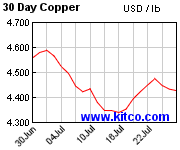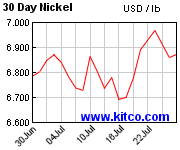 Last week, I was as intrigued with the political stories as many of you have been. Since I had purchased a copy of USA Today to read these revelations, I decided to read the rest of the paper. In the business section was the article “Coins cost more to make than face value” explaining that the US Mint estimates that it will cost 1.23 cents to strike the Lincoln Cent and 5.73 cents to strike the Return to Monticello nickel.
Last week, I was as intrigued with the political stories as many of you have been. Since I had purchased a copy of USA Today to read these revelations, I decided to read the rest of the paper. In the business section was the article “Coins cost more to make than face value” explaining that the US Mint estimates that it will cost 1.23 cents to strike the Lincoln Cent and 5.73 cents to strike the Return to Monticello nickel.
 This article and a similar article from Numismatic News explains that along with the rising metal prices, fuel and processing costs will has caused the price of production to rise. The composition of the cent is 97.5% zinc plated with copper (2.5 grams) and the nickel is made with 75% copper and 25% zinc (5 grams). As I write this, the closing price per pound of zinc is $1.4952, nickel is $9.4092, and copper closed at $3.6266. Prior to the change in 1982, the composition of the Lincoln cent was 95% copper and the rest tin and zinc with a weight of 3.11 grams.
This article and a similar article from Numismatic News explains that along with the rising metal prices, fuel and processing costs will has caused the price of production to rise. The composition of the cent is 97.5% zinc plated with copper (2.5 grams) and the nickel is made with 75% copper and 25% zinc (5 grams). As I write this, the closing price per pound of zinc is $1.4952, nickel is $9.4092, and copper closed at $3.6266. Prior to the change in 1982, the composition of the Lincoln cent was 95% copper and the rest tin and zinc with a weight of 3.11 grams.
 Before anyone starts to hoard these coins, the Mint told USA Today that the actual metal content of the cent is less than face value and the nickel is only fractionally more. Even if one was to hoard Lincoln cents from before 1982, the cost to process those coins to remove other metals and impurities would cost more than the net refined copper. With the rising cost of base metals, the future hoarding of US coinage could present an interesting problem.
Before anyone starts to hoard these coins, the Mint told USA Today that the actual metal content of the cent is less than face value and the nickel is only fractionally more. Even if one was to hoard Lincoln cents from before 1982, the cost to process those coins to remove other metals and impurities would cost more than the net refined copper. With the rising cost of base metals, the future hoarding of US coinage could present an interesting problem.
The Mint is one of the few profit-making agencies of the federal government. They reported a profit of $730 million last fiscal year. Mint officials estimate that profits will be down by approximately $45 million.
I wonder how that would change if the Bureau of Engraving and Printing stopped making $1 Federal Reserve Notes and the demand for $1 coins increased? But that is a discussion for another entry.


2 Comments